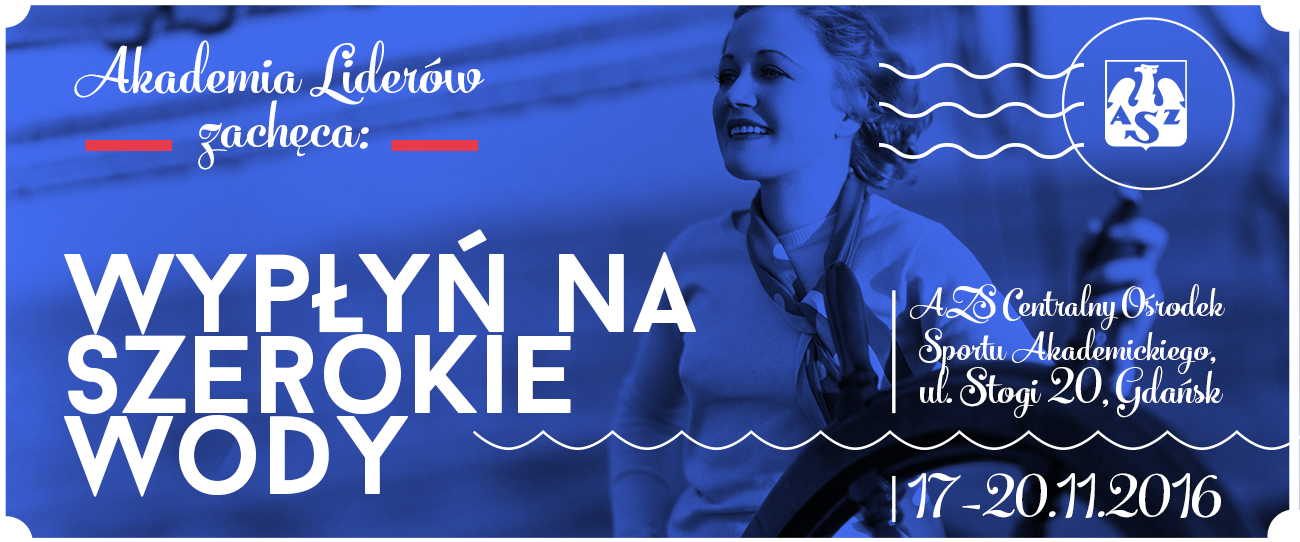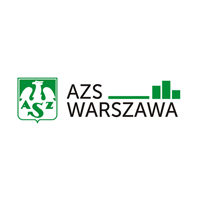

4 DNI, KTÓRE DADZĄ CI NOWE NARZĘDZIA I MOTYWACJĘ DO DZIAŁANIA ZE SWOIM ZESPOŁEM
termin: 17-20.11.2016 (czwartek – niedziela)
miejsce: AZS Centralny Ośrodek Sportu Akademickiego, ul. Stogi 20, Gdańsk
organizator: AZS Warszawa
KTO MOŻE WZIĄĆ UDZIAŁ W AKADEMII?
W szkoleniu mogą wziąć udział maksymalnie 2 osoby - studenci - reprezentujące Klub AZS (władze klubu). Liczba miejsc jest ograniczona. O przyjęciu zgłoszenia decyduje kolejność wpłynięcia (a także liczba osób z jednego klubu / środowiska)

KOSZTY UDZIAŁU
Koszty związane z pobytem i organizacją szkolenia (zakwaterowanie, wyżywienie, program szkolenia) od obiadu w dniu 17 listopada (czwartek), do śniadania w dniu 20 listopada (niedziela) częściowo pokrywa AZS. Każdy uczestnik szkolenia (dot. Klubów ze Środowisk AZS Warszawa, Olsztyn, Łódź, Białystok) zobowiązany jest do wpłacenia 150 PLN na pokrycie częściowych kosztów pobytu i organizacji. Opłaty można dokonać następująco: 1. Na konto AZS Warszawa, przelewając odpowiednią kwotę na nr bankowy: Bank BPH o/Warszawa 63 1060 0076 0000 3210 0018 1024 w opisie należy umieścić następującą treść: ``Udział w Szkoleniu`` lub 2. Gotówką, podczas szkolenia. Jeśli konieczne jest otrzymanie faktury za szkolenie, prosimy o wysłanie maila z taką prośbą na adres: ewa.ziolkowska@azs.pl, wpisując w treści dane do faktury oraz zamieszczając potwierdzenie przelewu. Dojazd na miejsce we własnym zakresie lub w gestii Waszego Klubu AZS / Środowiska AZS.

ZGŁOSZENIA
Zgłoszenia do udziału w szkoleniu przyjmowane są wyłącznie za pośrednictwem formularza internetowego. Termin zgłoszeń: do 14 listopada 2016 (poniedziałek), do godz. 12.00.
W PROGRAMIE AKADEMII:
- team building – działanie w zespole
- prowadzenie klubowego zebrania
- organizacja klubowych wydarzeń
- prezentacja działalności wybranych klubów uczelnianych AZS
- przygotowanie sekcji do rozgrywek (liga międzyuczelniana, AMP)
- spotkania z przedstawicielami władz AZS
- inspirujące projekty AZS Gdańsk

Dominika Borowiec, na co dzień związana z Klubem Uczelnianym AZS UG, wzorowa pracownica AZS Gdańsk. Specjalistka od środowiskowych akcji charytatywnych i imprez nietypowych (Nocne Granie AZS, Charytatywne Maratony ZUMBY i tenisa, zbiórki w ramach Szlachetnej Paczki, Gdańskie Dni Sąsiadów...)
W czasie wolnym od AZSu nie zwalnia tempa - dzierga i szydełkuje.
W trakcie Akademii przybliży akcję AZS dla Promyka - charytatywny maraton Zumby dla podopiecznych schroniska dla zwierząt.
DOMINIKA BOROWIEC
AZS DLA PROMYKA
Przybliżę Wam działalność Klubu Uczelnianego AZS Politechniki Łódzkiej, zrealizowane projekty oraz wymierzone cele. Przy okazji podzielę się moimi doświadczeniami, wskażę co AZS zmienił w moim życiu, jak pozwolił mi się samodoskonalić i jakie możliwości przede mną otworzył. Krótko mówiąc, przedstawię moją drogę od „świeżaka” do porządnego AZSiaka.
PATRYCJA CYNIAK
OD ŚWIEŻAKA DO AZSIAKA
Od początku studiów zarażony AZS-em, aktywny i gotowy do działania w Klubie Uczelnianym AZS SGGW. Rzucony przez starszych kolegów na głęboką wodę szybko przepłynąłem przez kolejne szczeble klubowej hierarchii. Opowiem o tym jak starałem się zmienić działania naszego Klubu oraz jakie dalsze cele stawiam przed sobą i naszym Klubem, aby AZS SGGW wypłynął na szerokie wody.
ARTUR SŁOMKA
ZMIANY, CELE, WYZWANIA
Wolontariusz podczas AME i AMŚ, członek Zarządu KU i OŚ, korespondent APS, kierownik imprez lekkoatletycznych, koordynator sportu wyczynowego – podczas mojego kilkunastoletniego związku z AZS żadne zadanie nie było mi straszne. Przedstawię Wam działalność mojego macierzystego KU AZS UŁ i Organizacji Środowiskowej AZS w Łodzi, w której pracuję na co dzień. Opowiem także jak AZS pozwala spełniać marzenia i umożliwia działalność w sporcie przez duże „S”.
ALEKSANDRA LESZCZYŃSKA
Z AZS-EM PRZEZ ŻYCIE
Socjolog po studiach ekonomicznych, wykładowca i prawie doktor. Certyfikowany coach i doświadczony trener. Facylitator i mentor. Specjalista od budowania strategii, dobrego zarządzania i pracy z ludźmi. Pomaga uczyć się m.in. lepszej komunikacji, negocjacji, asertywności, wyznaczania celów i pracy z grupą. Opowie i pokaże jak dobrze organizować pracę zespołu. www.chudkiewi.cz
MACIEK CHUDKIEWICZ
ORGANIZACJA PRACY ZESPOŁU
Zawodowo animator, doradca ds. marketingu i komunikacji społecznościowej.
Prywatnie społecznik zaangażowany projektowo zarówno w inicjatywy AZS jak i Stowarzyszenia „Możesz”. W swojej prezentacji przedstawię wybrane projekty, w których miałem/mam swój udział jako lider. W każdym z nich moja rola miała jednak zupełnie inny charakter. Co ważne, za każdym razem udało się dotrzeć do celu. Dzięki komu? Dowiecie się w trakcie Akademii.
MARIUSZ WALCZAK
JEDEN Z DZIESIĘCIU
Ireneusz Urbaś - kiedyś Prezes Klubu Uczelnianego AZS Politechniki Gdańskiej dzisiaj Prezes AZS Organizacji Środowiskowej w Gdańsku. Pozytywnie zakręcony od zawsze w głowie ma zwariowane pomysły, które stara się wcielać w życie. Jego pasje to AZS i projektowanie. Na co dzień kieruje firmą ``Studio Marzeń`` . Autor bloga ``Co we wnętrzach piszczy``. W trakcie Akademii przedstawi flagową akcję AZS Gdańsk i Steny Line - Rowerowy Potop AZS.


